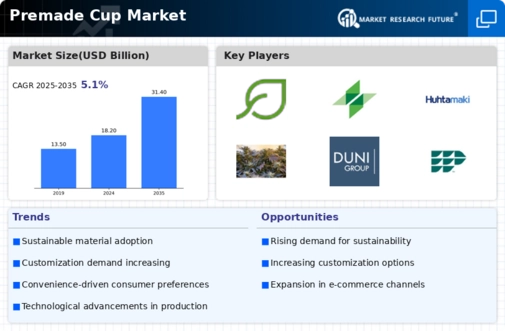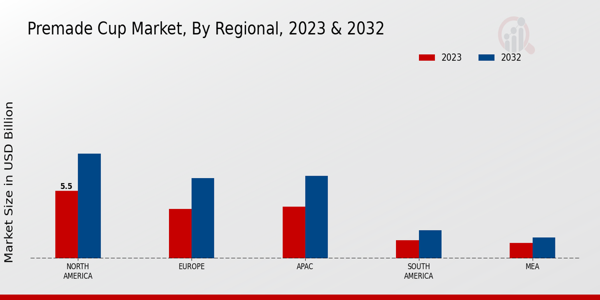Market Growth Projections
The Global Premade Cup Market Industry is poised for substantial growth, with projections indicating a market value of 18.2 USD Billion in 2024 and an anticipated increase to 31.4 USD Billion by 2035. This growth trajectory suggests a compound annual growth rate of 5.08% from 2025 to 2035, reflecting the industry's resilience and adaptability in a dynamic market environment. Factors such as rising consumer demand for convenience, sustainability, and innovation in packaging solutions are likely to drive this growth. The market's expansion presents opportunities for stakeholders to capitalize on emerging trends and consumer preferences.
Sustainable Packaging Demand
The Global Premade Cup Market Industry experiences a notable surge in demand for sustainable packaging solutions. As consumers become increasingly environmentally conscious, manufacturers are compelled to adopt eco-friendly materials and production processes. This shift is reflected in the growing preference for biodegradable and recyclable premade cups, which aligns with global sustainability goals. The industry's response to this trend is crucial, as it not only meets consumer expectations but also adheres to regulatory standards aimed at reducing plastic waste. Consequently, this driver is expected to significantly influence market dynamics, contributing to the projected market value of 18.2 USD Billion in 2024.
Health and Safety Regulations
Health and safety regulations significantly impact the Global Premade Cup Market Industry. Stringent regulations regarding food safety and hygiene compel manufacturers to adhere to high standards in production and materials used. This regulatory landscape drives innovation, as companies invest in safer, more reliable packaging solutions that comply with health guidelines. The emphasis on consumer safety not only enhances product credibility but also fosters consumer trust in premade cup products. As regulations evolve, the industry must adapt, potentially leading to increased costs but also opportunities for differentiation in a competitive market.
Convenience and On-the-Go Consumption
The Global Premade Cup Market Industry is significantly influenced by the rising trend of convenience and on-the-go consumption. As lifestyles evolve, consumers increasingly seek products that facilitate quick and easy consumption, particularly in urban areas. Premade cups cater to this demand by offering ready-to-use solutions for beverages and snacks. This trend is particularly evident in the foodservice sector, where quick-service restaurants and cafes utilize premade cups to enhance customer experience. The convenience factor is likely to drive market growth, contributing to the anticipated increase in market value to 31.4 USD Billion by 2035.
Growth of the Food and Beverage Sector
The Global Premade Cup Market Industry is closely tied to the expansion of the food and beverage sector. As this sector continues to grow, driven by increasing consumer spending and changing dietary habits, the demand for premade cups rises correspondingly. Restaurants, cafes, and food delivery services increasingly rely on premade cups for their convenience and efficiency. This trend is particularly pronounced in regions with burgeoning foodservice industries, where the need for portable and ready-to-eat solutions is paramount. The anticipated growth in this sector is expected to bolster the market, supporting a compound annual growth rate of 5.08% from 2025 to 2035.
Technological Advancements in Production
Technological advancements play a pivotal role in shaping the Global Premade Cup Market Industry. Innovations in manufacturing processes, such as automation and improved material science, enhance production efficiency and product quality. These advancements enable manufacturers to produce a wider variety of premade cups that meet diverse consumer preferences. Additionally, the integration of smart technologies in packaging, such as QR codes for traceability, is gaining traction. This technological evolution not only streamlines operations but also aligns with consumer demands for transparency and quality assurance, thereby fostering market growth.













